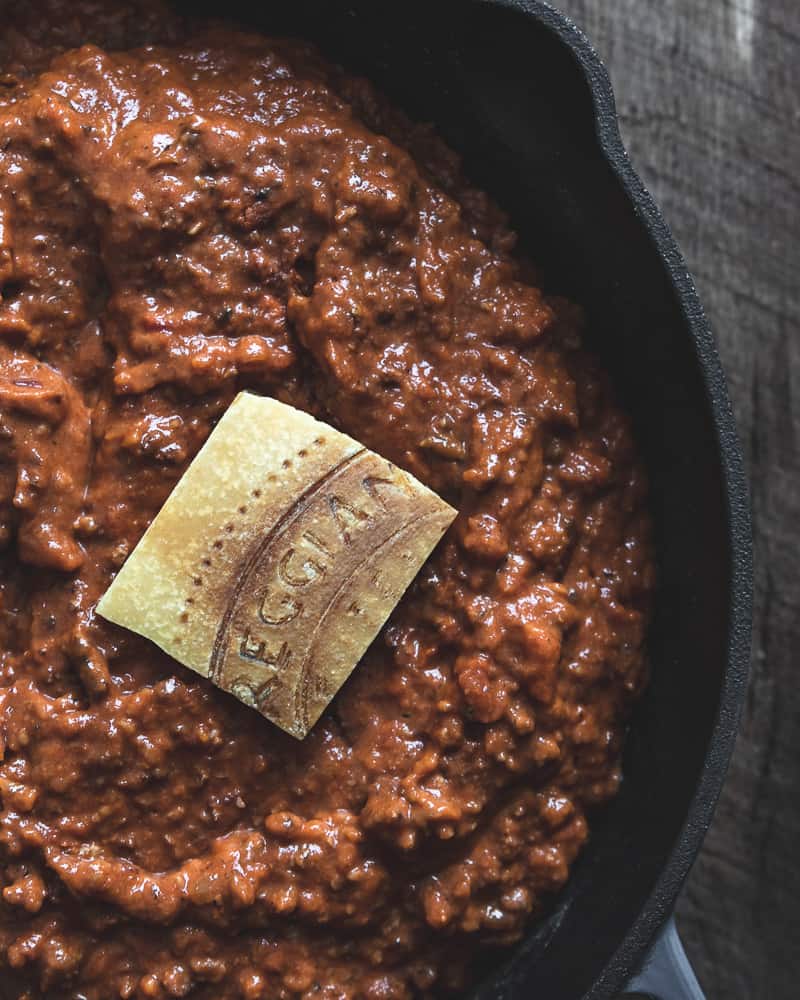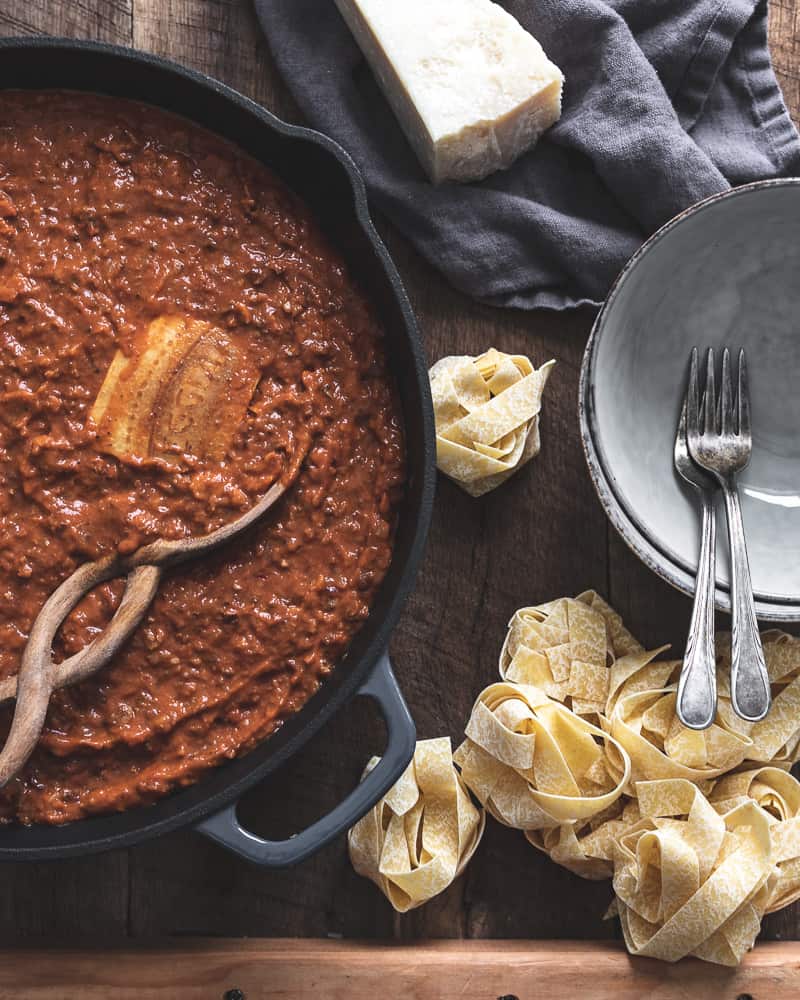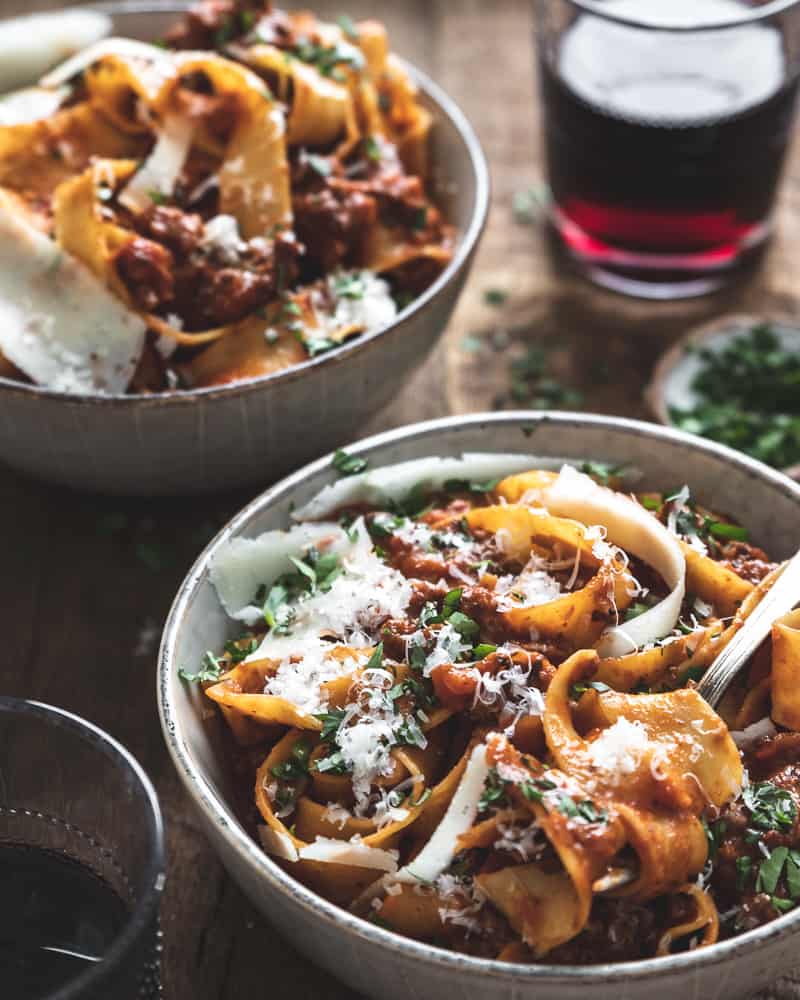Wild Thistle Kitchen: Authentic Bolognese Sauce
By • February 11, 2021 0 2255

After a week of slinging quick-cooked dinners at my family, I absolutely love having the luxury of lazy weekend days to cook whatever I feel like. I crave the opportunity to doodle around in the kitchen all day, making a recipe that just gets better with time.
My authentic bolognese sauce is just that. One of my favorite weekend recipes — especially when it’s chilly outside. It’s about a three-to-four-hour process, but most of the time it’s just bubbling away, making my house smell amazing. I imagine if I had an Italian grandmother, this is what her house would always smell like.
Once you gather the ingredients, it doesn’t take long at all: maybe 45 minutes to get to the point where you can just ignore it. This recipe makes a nice big batch, and it freezes beautifully. I like to serve it with pappardelle or tagliatelle, but linguine or fettuccine is good, too. Really, any noodle you choose will be perfect. My kids love the “little ears” (orecchiette) because the sauce gets stuck inside them. It also makes the best (best!) lasagna. And, of course, you can never go wrong tossing some in a bowl and dipping really good, crusty bread in it.
What makes this bolognese authentic? I’m glad you asked.
I have read many Italian cookbooks, scoured the internet for recipes and articles and watched so many travel and cooking documentaries. I basically added all the recipes up and combined all of the best and most frequently recurring ingredients.
Let’s break down an authentic Bolognese …
- Meat: a combo of beef and pork is very authentic and very delicious. Veal can be used as well.
- Soffritto: known as mirepoix in French cooking. A classic flavor building block. A mix of chopped celery, carrot and onion. In Italian cooking, garlic and often parsley are included.
- Tomato: I use tomato paste and crushed tomatoes to layer the flavors.
- Liquid: wine, broth and milk are all added at different times to add moisture, richness and acidity. Using homemade or really high-quality store-bought broth makes a huge difference. About that wine — you can use red or white. For a long time, I only used red in my authentic bolognese, but I really love the white these days.
- Flavor-boosting secret weapons: pancetta, porcini mushrooms and parmigiano reggiano rinds all add a salty, meaty, umami undertone that can’t be replicated. I love sneaking in a couple of anchovies (shhh!).
- Herbs: important in all cuisines, but, I feel, especially in Italian cooking. Bay leaves while it simmers. Rosemary for earthiness and depth. And fresh parsley for a bit of brightness when serving.
An important note on making this sauce: Make sure you really, really brown the meat and veggies. Like, get the meat to the point where it’s sizzling and popping, even sticking to the bottom of the pan and scaring you a little. This caramelization is how you get the deep, rich flavor in the finished sauce. I often use separate pans as it allows me to get the veggies and meat going at the same time, while also allowing them to brown individually. Veggies have a lot of water, and it would be very difficult to get the meat properly browned if they were combined. By the time the meat finally browned, the veggies would undoubtedly burn! It’s only one extra pan to wash. I promise it’s worth it — I mean, how often are you making authentic bolognese? Take your time, channel your inner Italian, blast some Pavarotti, pour a glass of wine and enjoy the process.
Yes, there is another option. But having written that, you don’t have to use two pans. You will start with the meat and then basically deglaze the pan with the veggies. I’ve given instructions for both in the recipe.
Okay, a few more tips.
I know this might sound weird, but I rinse the dried porcini before I soak them in the stock. I know everyone says not to rinse mushrooms, but (1) I’m a rebel, (2) they’re going to soak anyway and (3) porcini are notoriously gritty and I’m not wasting four hours making a gritty bolognese. So there.
Also, even if you don’t think you like mushrooms, you have to trust me, these will be ground up so small that, texturally, you won’t notice them. When it comes to the flavor though, they are so important. They add such a depth and richness and really round out the flavors.
Same goes for the anchovies. I promise you won’t taste them. My kids will read this one day and yell at me for sneaking anchovies into their meals, but, in the meantime, ignorance is delicious bliss.
I promise, if you made a batch of this minus the porcini, anchovies and parm rinds and then you made one with them all, the one WITH them would win any contest. Those secret flavor boosters really do their job and add a depth and (dare I write it again) an umami richness and savoriness that cannot be replicated.
Speaking of secret flavor boosters, one of my blogger friends over at Well Seasoned Studio adds chicken livers to her bolognese and I am definitely going to try it. Just such a brilliant flavor weapon! Here is a link to Ari’s Rigatoni Bolognese.
Here are a few of the recipes I referenced when coming up with my authentic bolognese:
Perciatelli with Bolognese (Geoffrey Zakarian)
Marcella Hazan’s Bolognese Sauce (New York Times)
Classic Ragu Bolognese (Bon Appétit)
And there were many more that I watched over the years or read about in my dad’s old cookbooks. I think it is important to honor the authenticity and history of recipes while also making them your own by adding your secret weapons (anchovies! chicken livers! parm rinds!) or by using a technique that works better for you and your style of cooking. This was how my father cooked. He read and read, researched and learned, traveled and paid attention. Then he came home and put it all together and made magic.
Authentic Bolognese Sauce
Prep Time: 45 minutes
Cook Time: 3 hours
Ingredients
4 oz. pancetta, diced
1 oz. dried porcini
4 cloves fresh garlic
1 medium onion, peeled and diced
2 carrots, peeled and diced
2 celery stalks, diced
1 lb. ground pork
1 lb. ground beef
6 oz. tomato paste (one small can)
2 cups wine, red or white
4 cups chicken or beef broth (homemade if you can — choose a good all-natural, low-sodium one if store-bought)
2 cups whole milk
28-oz. can crushed tomatoes
Parmesan cheese rind
2 bay leaves
Extra virgin olive oil
Salt and pepper
Tablespoon fresh rosemary, chopped

Photo by Anita Parris Soule. Courtesy Wild Thistle Kitchen.
Instructions
In a small sauce pan, combine 4 cups of stock with the rinsed porcini. Bring to a simmer while you begin to prep the veggies. You can either small-dice the veggies by hand or roughly chop onion, celery, carrot and garlic and add to the bowl of a food processor. Pulse until all ingredients are finely minced but not turned to mush.
Preheat a large Dutch oven with a few tablespoons of olive oil. Sauté pancetta for a minute or two before adding the minced veggies, rosemary, a big pinch of salt (teaspoon) and a few grinds of black pepper.
Once porcini are soft, carefully scoop them out (reserving the stock for later) and add them to the same food processor bowl. Pulse until very finely minced and add to the Dutch oven with the veggies. Slowly sauté while you get the meat started.
Preheat a separate large skillet or Dutch oven over medium-high heat with a few tablespoons of olive oil (at least a 10-to-12-inch skillet, but larger if you have it). Add meat, 1 teaspoon kosher salt and a few grinds of black pepper. Break meat up with a wooden spoon and stir every few minutes. This process should take at least 20 minutes, but up to 30 minutes to get the proper caramelization.
Once your veggies are really soft and beginning to brown (should take about 20 minutes), add anchovies and tomato paste and cook for another minute.
Once the meat is really brown (should take about 20 to 30 minutes), add 1 cup of wine to the skillet and scrape the pan, getting all the brown bits off the bottom. Add the meat to the Dutch oven with the veggie/tomato paste mixture, and add another cup of wine.
Give it a big stir, and allow the wine to reduce for about 5 minutes, then add crushed tomatoes, stock, milk, bay leaves and parmesan cheese rind. Bring to a simmer and cook very gently for 3 to 4 hours — you want it barely bubbling. Stir occasionally.
Remove the bay leaves and parmesan cheese rind when finished.
This sauce gets better as it sits, and is even more delicious the next day and the day after. It is so rich and satisfying.
If you only want to use one pan …
In a large Dutch oven, begin by browning meat as instructed above, except here you will add the pancetta to the meat and brown them all together. Once meat is very brown and caramelized, turn heat to medium and add all veggies and mushrooms and cook until softened and caramelized, scraping bottom as you go.
Once veggies are softened, after about 20 minutes, add tomato paste and anchovy, cook for about 5 minutes, then add total amount of wine and continue with the last three steps.
When you’re ready to serve, cook your favorite noodles just a little under al dente, and reserve a cup or two of the pasta water. The Italian trick to finishing pasta is to cook the noodles with the sauce and a little pasta water for the last few minutes. It makes a huge difference, and is so much better than just plopping sauce on top of noodles.
So … transfer the sauce you aren’t using to containers. When your pasta is done, add it directly to the remaining sauce in the pot along with a little pasta water and cook over medium heat for a few minutes until it is thick and glossy. I just toss it around with tongs and shake the pan until the sauce really clings to the noodles. You want plenty of sauce, but not so much that the noodles are drowning in it. Serve with fresh chopped parsley and/or basil and LOTS of freshly grated parmigiano and/or pecorino romano (I like a combo, like my dad always used).

Photo by Anita Parris Soule. Courtesy Wild Thistle Kitchen.

